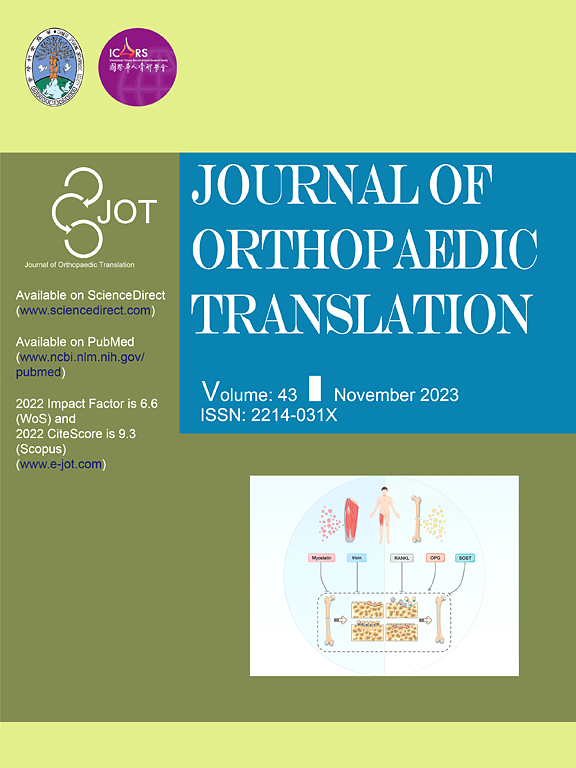生物3d打印机制备的ADSCs无支架结构促进兔ACL重建后骨肌腱愈合
IF 5.9
1区 医学
Q1 ORTHOPEDICS
引用次数: 0
摘要
背景/目的:研究脂肪组织源性间充质细胞(ADSCs)对兔前交叉韧带(ACL)重建骨肌腱愈合的影响。方法对19只成年雄性日本大白兔进行双侧ACL重建。将ADSC假体植入兔右侧股骨隧道(假体组),左膝为对照组,不植入假体。9只兔分别于术后3周和6周处死,其余兔术后立即处死。对6只家兔进行生物力学和显微计算机断层扫描评价,对其余3只家兔进行组织学观察。结果表明:(1)术后3周,种植体组的失效负荷明显大于对照组。(2)最初,种植体组股骨隧道内的新骨量在3周时较低,但在6周时超过对照组。(3)组织学分析显示种植体组骨肌腱愈合速度快于对照组。结论ADSC构建物对兔前交叉韧带重建后骨肌腱愈合有积极作用。然而,使用更大的动物模型的进一步研究必须全面证实这些影响。无支架自体ADSC构建体移植是一种安全可靠的不使用异物将ADSC移植到肌腱-骨隧道界面的技术。可应用于前交叉韧带重建手术中骨肌腱愈合等部位,如肩袖、跟腱附着部位。本文章由计算机程序翻译,如有差异,请以英文原文为准。

Promotion of bone-tendon healing after ACL reconstruction using scaffold-free constructs comprising ADSCs produced by a bio-3D printer in rabbit models
Background/Objective: This study evaluated the impact of adipose tissue-derived mesenchymal stromal cells (ADSCs) on bone-tendon healing in rabbit anterior cruciate ligament (ACL) reconstruction.
Methods
Nineteen mature male Japanese White rabbits underwent bilateral ACL reconstruction. ADSC constructs were implanted in the right femoral bone tunnel of each rabbit (implant group), while the left knee served as the control group without implantation. Nine rabbits were sacrificed at 3 and 6 weeks post-surgery, while the remaining were sacrificed immediately post-surgery. Biomechanical and micro computed tomography evaluations were conducted on six rabbits, while histological observation was performed on the remaining three.
Results
showed: (1) The implant group exhibited a significantly greater failure load than the control group at 3 weeks post-surgery. (2) Initially, the amount of new bone in the femoral tunnel was lower in the implant group at 3 weeks but surpassed that of the control group by 6 weeks. (3) Histological analysis indicated faster bone-tendon healing in the implant group than that of the control.
Conclusion
These findings suggest a positive effect of ADSC constructs on bone-tendon healing post-ACL reconstruction in rabbits. However, further studies using larger animal models must confirm these effects comprehensively.
The translational potential of this article
The method of transplanting a scaffold-free autologous ADSC construct is a technique that can safely and reliably transplant ADSCs to the tendon-bone tunnel interface without using foreign substances. It can be applied to bone-tendon healing in ACL reconstruction surgery and other areas, such as the rotator cuff and Achilles tendon attachment site.
求助全文
通过发布文献求助,成功后即可免费获取论文全文。
去求助
来源期刊

Journal of Orthopaedic Translation
Medicine-Orthopedics and Sports Medicine
CiteScore
11.80
自引率
13.60%
发文量
91
审稿时长
29 days
期刊介绍:
The Journal of Orthopaedic Translation (JOT) is the official peer-reviewed, open access journal of the Chinese Speaking Orthopaedic Society (CSOS) and the International Chinese Musculoskeletal Research Society (ICMRS). It is published quarterly, in January, April, July and October, by Elsevier.
 求助内容:
求助内容: 应助结果提醒方式:
应助结果提醒方式:


